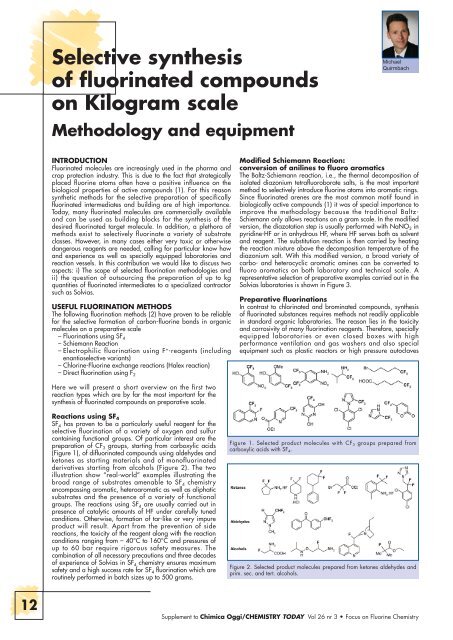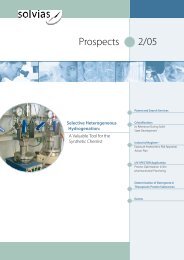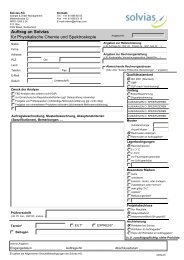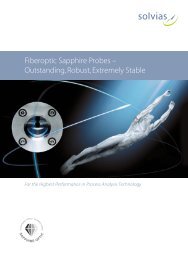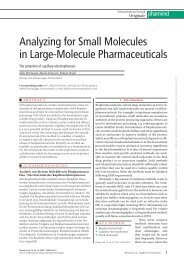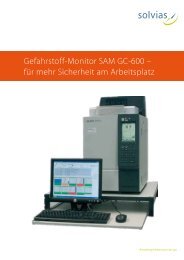Selective synthesis of fluorinated compounds on kilogram ... - Solvias
Selective synthesis of fluorinated compounds on kilogram ... - Solvias
Selective synthesis of fluorinated compounds on kilogram ... - Solvias
Create successful ePaper yourself
Turn your PDF publications into a flip-book with our unique Google optimized e-Paper software.
12<br />
<str<strong>on</strong>g>Selective</str<strong>on</strong>g> <str<strong>on</strong>g>synthesis</str<strong>on</strong>g><br />
<str<strong>on</strong>g>of</str<strong>on</strong>g> <str<strong>on</strong>g>fluorinated</str<strong>on</strong>g> <str<strong>on</strong>g>compounds</str<strong>on</strong>g><br />
<strong>on</strong> Kilogram scale<br />
Methodology and equipment<br />
INTRODUCTION<br />
Fluorinated molecules are increasingly used in the pharma and<br />
crop protecti<strong>on</strong> industry. This is due to the fact that strategically<br />
placed fluorine atoms <str<strong>on</strong>g>of</str<strong>on</strong>g>ten have a positive influence <strong>on</strong> the<br />
biological properties <str<strong>on</strong>g>of</str<strong>on</strong>g> active <str<strong>on</strong>g>compounds</str<strong>on</strong>g> (1). For this reas<strong>on</strong><br />
synthetic methods for the selective preparati<strong>on</strong> <str<strong>on</strong>g>of</str<strong>on</strong>g> specifically<br />
<str<strong>on</strong>g>fluorinated</str<strong>on</strong>g> intermediates and building are <str<strong>on</strong>g>of</str<strong>on</strong>g> high importance.<br />
Today, many <str<strong>on</strong>g>fluorinated</str<strong>on</strong>g> molecules are commercially available<br />
and can be used as building blocks for the <str<strong>on</strong>g>synthesis</str<strong>on</strong>g> <str<strong>on</strong>g>of</str<strong>on</strong>g> the<br />
desired <str<strong>on</strong>g>fluorinated</str<strong>on</strong>g> target molecule. In additi<strong>on</strong>, a plethora <str<strong>on</strong>g>of</str<strong>on</strong>g><br />
methods exist to selectively fluorinate a variety <str<strong>on</strong>g>of</str<strong>on</strong>g> substrate<br />
classes. However, in many cases either very toxic or otherwise<br />
dangerous reagents are needed, calling for particular know how<br />
and experience as well as specially equipped laboratories and<br />
reacti<strong>on</strong> vessels. In this c<strong>on</strong>tributi<strong>on</strong> we would like to discuss two<br />
aspects: i) The scope <str<strong>on</strong>g>of</str<strong>on</strong>g> selected fluorinati<strong>on</strong> methodologies and<br />
ii) the questi<strong>on</strong> <str<strong>on</strong>g>of</str<strong>on</strong>g> outsourcing the preparati<strong>on</strong> <str<strong>on</strong>g>of</str<strong>on</strong>g> up to kg<br />
quantities <str<strong>on</strong>g>of</str<strong>on</strong>g> <str<strong>on</strong>g>fluorinated</str<strong>on</strong>g> intermediates to a specialized c<strong>on</strong>tractor<br />
such as <strong>Solvias</strong>.<br />
USEFUL FLUORINATION METHODS<br />
The following fluorinati<strong>on</strong> methods (2) have proven to be reliable<br />
for the selective formati<strong>on</strong> <str<strong>on</strong>g>of</str<strong>on</strong>g> carb<strong>on</strong>-fluorine b<strong>on</strong>ds in organic<br />
molecules <strong>on</strong> a preparative scale<br />
– Fluorinati<strong>on</strong>s using SF 4<br />
– Schiemann Reacti<strong>on</strong><br />
– Electrophilic fluorinati<strong>on</strong> using F + -reagents (including<br />
enantioselective variants)<br />
– Chlorine-Fluorine exchange reacti<strong>on</strong>s (Halex reacti<strong>on</strong>)<br />
– Direct fluorinati<strong>on</strong> using F 2<br />
Here we will present a short overview <strong>on</strong> the first two<br />
reacti<strong>on</strong> types which are by far the most important for the<br />
<str<strong>on</strong>g>synthesis</str<strong>on</strong>g> <str<strong>on</strong>g>of</str<strong>on</strong>g> <str<strong>on</strong>g>fluorinated</str<strong>on</strong>g> <str<strong>on</strong>g>compounds</str<strong>on</strong>g> <strong>on</strong> preparative scale.<br />
Reacti<strong>on</strong>s using SF 4<br />
SF 4 has proven to be a particularly useful reagent for the<br />
selective fluorinati<strong>on</strong> <str<strong>on</strong>g>of</str<strong>on</strong>g> a variety <str<strong>on</strong>g>of</str<strong>on</strong>g> oxygen and sulfur<br />
c<strong>on</strong>taining functi<strong>on</strong>al groups. Of particular interest are the<br />
preparati<strong>on</strong> <str<strong>on</strong>g>of</str<strong>on</strong>g> CF 3 groups, starting from carboxylic acids<br />
(Figure 1), <str<strong>on</strong>g>of</str<strong>on</strong>g> di<str<strong>on</strong>g>fluorinated</str<strong>on</strong>g> <str<strong>on</strong>g>compounds</str<strong>on</strong>g> using aldehydes and<br />
ket<strong>on</strong>es as starting materials and <str<strong>on</strong>g>of</str<strong>on</strong>g> m<strong>on</strong><str<strong>on</strong>g>of</str<strong>on</strong>g>luorinated<br />
derivatives starting from alcohols (Figure 2). The two<br />
illustrati<strong>on</strong> show “real-world” examples illustrating the<br />
broad range <str<strong>on</strong>g>of</str<strong>on</strong>g> substrates amenable to SF 4 chemistry<br />
encompassing aromatic, heteroaromatic as well as aliphatic<br />
substrates and the presence <str<strong>on</strong>g>of</str<strong>on</strong>g> a variety <str<strong>on</strong>g>of</str<strong>on</strong>g> functi<strong>on</strong>al<br />
groups. The reacti<strong>on</strong>s using SF 4 are usually carried out in<br />
presence <str<strong>on</strong>g>of</str<strong>on</strong>g> catalytic amounts <str<strong>on</strong>g>of</str<strong>on</strong>g> HF under carefully tuned<br />
c<strong>on</strong>diti<strong>on</strong>s. Otherwise, formati<strong>on</strong> <str<strong>on</strong>g>of</str<strong>on</strong>g> tar-like or very impure<br />
product will result. Apart from the preventi<strong>on</strong> <str<strong>on</strong>g>of</str<strong>on</strong>g> side<br />
reacti<strong>on</strong>s, the toxicity <str<strong>on</strong>g>of</str<strong>on</strong>g> the reagent al<strong>on</strong>g with the reacti<strong>on</strong><br />
c<strong>on</strong>diti<strong>on</strong>s ranging from – 40°C to 160°C and pressures <str<strong>on</strong>g>of</str<strong>on</strong>g><br />
up to 60 bar require rigorous safety measures. The<br />
combinati<strong>on</strong> <str<strong>on</strong>g>of</str<strong>on</strong>g> all necessary precauti<strong>on</strong>s and three decades<br />
<str<strong>on</strong>g>of</str<strong>on</strong>g> experience <str<strong>on</strong>g>of</str<strong>on</strong>g> <strong>Solvias</strong> in SF 4 chemistry ensures maximum<br />
safety and a high success rate for SF 4 fluorinati<strong>on</strong> which are<br />
routinely performed in batch sizes up to 500 grams.<br />
Michael<br />
Quirmbach<br />
Modified Schiemann Reacti<strong>on</strong>:<br />
c<strong>on</strong>versi<strong>on</strong> <str<strong>on</strong>g>of</str<strong>on</strong>g> anilines to fluoro aromatics<br />
The Baltz-Schiemann reacti<strong>on</strong>, i.e., the thermal decompositi<strong>on</strong> <str<strong>on</strong>g>of</str<strong>on</strong>g><br />
isolated diaz<strong>on</strong>ium tetrafluoroborate salts, is the most important<br />
method to selectively introduce fluorine atoms into aromatic rings.<br />
Since <str<strong>on</strong>g>fluorinated</str<strong>on</strong>g> arenes are the most comm<strong>on</strong> motif found in<br />
biologically active <str<strong>on</strong>g>compounds</str<strong>on</strong>g> (1) it was <str<strong>on</strong>g>of</str<strong>on</strong>g> special importance to<br />
improve the methodology because the traditi<strong>on</strong>al Baltz-<br />
Schiemann <strong>on</strong>ly allows reacti<strong>on</strong>s <strong>on</strong> a gram scale. In the modified<br />
versi<strong>on</strong>, the diazotati<strong>on</strong> step is usually performed with NaNO 2 in<br />
pyridine-HF or in anhydrous HF, where HF serves both as solvent<br />
and reagent. The substituti<strong>on</strong> reacti<strong>on</strong> is then carried by heating<br />
the reacti<strong>on</strong> mixture above the decompositi<strong>on</strong> temperature <str<strong>on</strong>g>of</str<strong>on</strong>g> the<br />
diaz<strong>on</strong>ium salt. With this modified versi<strong>on</strong>, a broad variety <str<strong>on</strong>g>of</str<strong>on</strong>g><br />
carbo- and heterocyclic aromatic amines can be c<strong>on</strong>verted to<br />
fluoro aromatics <strong>on</strong> both laboratory and technical scale. A<br />
representative selecti<strong>on</strong> <str<strong>on</strong>g>of</str<strong>on</strong>g> preparative examples carried out in the<br />
<strong>Solvias</strong> laboratories is shown in Figure 3.<br />
Preparative fluorinati<strong>on</strong>s<br />
In c<strong>on</strong>trast to chlorinated and brominated <str<strong>on</strong>g>compounds</str<strong>on</strong>g>, <str<strong>on</strong>g>synthesis</str<strong>on</strong>g><br />
<str<strong>on</strong>g>of</str<strong>on</strong>g> <str<strong>on</strong>g>fluorinated</str<strong>on</strong>g> substances requires methods not readily applicable<br />
in standard organic laboratories. The reas<strong>on</strong> lies in the toxicity<br />
and corrosivity <str<strong>on</strong>g>of</str<strong>on</strong>g> many fluorinati<strong>on</strong> reagents. Therefore, specially<br />
equipped laboratories or even closed boxes with high<br />
performance ventilati<strong>on</strong> and gas washers and also special<br />
equipment such as plastic reactors or high pressure autoclaves<br />
Figure 1. Selected product molecules with CF 3 groups prepared from<br />
carboxylic acids with SF 4.<br />
Figure 2. Selected product molecules prepared from ket<strong>on</strong>es aldehydes and<br />
prim. sec. and tert. alcohols.<br />
Supplement to Chimica Oggi/CHEMISTRY TODAY Vol 26 nr 3 • Focus <strong>on</strong> Fluorine Chemistry
Figure 3. Scope <str<strong>on</strong>g>of</str<strong>on</strong>g> the modified Schiemann reacti<strong>on</strong>s to prepare fluoroaromatic<br />
<str<strong>on</strong>g>compounds</str<strong>on</strong>g>.<br />
made <str<strong>on</strong>g>of</str<strong>on</strong>g> M<strong>on</strong>el 400 ® are <str<strong>on</strong>g>of</str<strong>on</strong>g>ten required. In additi<strong>on</strong>, trained pers<strong>on</strong>nel<br />
with experience in handling toxic and aggressive chemicals as well as<br />
high-pressure apparatuses are a prerequisite as well.<br />
This leads to the obvious questi<strong>on</strong>: If a <str<strong>on</strong>g>fluorinated</str<strong>on</strong>g> intermediate is not<br />
available commercially, do you prepare it yourself or outsource the<br />
preparati<strong>on</strong> to a specialist? While many electrophilic fluorinati<strong>on</strong>s using F + -<br />
reagents such Selectfluor ® * can be carried out by experienced pers<strong>on</strong>nel<br />
<strong>on</strong> preparative scale without any special precauti<strong>on</strong>, this is not<br />
recommendable for reacti<strong>on</strong>s with reagents such as HF or SF 4. For such<br />
preparati<strong>on</strong>s, outsourcing to a specialized company such as <strong>Solvias</strong> is<br />
clearly the method <str<strong>on</strong>g>of</str<strong>on</strong>g> choice.<br />
For more than 30 years, a variety <str<strong>on</strong>g>of</str<strong>on</strong>g> different fluorinati<strong>on</strong> methods have<br />
been used at <strong>Solvias</strong> to prepare hundreds <str<strong>on</strong>g>of</str<strong>on</strong>g> <str<strong>on</strong>g>fluorinated</str<strong>on</strong>g> <str<strong>on</strong>g>compounds</str<strong>on</strong>g> <strong>on</strong> a<br />
preparative scale.<br />
Fluorinati<strong>on</strong>s are<br />
routinely carried out<br />
in various scales up to<br />
16 litres. We not <strong>on</strong>ly<br />
have all equipment<br />
required (several<br />
specialized vessels<br />
and autoclaves are<br />
depicted in Figure 4),<br />
but also the knowhow<br />
and experience<br />
to successfully<br />
synthesize <str<strong>on</strong>g>fluorinated</str<strong>on</strong>g><br />
target molecules <strong>on</strong><br />
gram to <strong>kilogram</strong><br />
scale and develop<br />
efficient processes for<br />
large-scale manufacturing. Besides the transformati<strong>on</strong>s described above,<br />
<strong>Solvias</strong> can also perform reacti<strong>on</strong>s with almost every fluorinati<strong>on</strong> reagent,<br />
including diluted F 2 gas (e.g. 10 percent F 2 in N 2) under normal pressure<br />
and up to a 0,5 mol scale.<br />
CONCLUSIONS<br />
This brief overview dem<strong>on</strong>strates that a variety <str<strong>on</strong>g>of</str<strong>on</strong>g> methods are available for<br />
the preparati<strong>on</strong> <str<strong>on</strong>g>of</str<strong>on</strong>g> selectively <str<strong>on</strong>g>fluorinated</str<strong>on</strong>g> <str<strong>on</strong>g>compounds</str<strong>on</strong>g> and that several<br />
transformati<strong>on</strong>s are feasible to be applied a <strong>kilogram</strong> scale. A drawback <str<strong>on</strong>g>of</str<strong>on</strong>g><br />
most fluorinating chemistry is the toxic and sometimes aggressive nature <str<strong>on</strong>g>of</str<strong>on</strong>g><br />
many fluorinati<strong>on</strong> reagents. For this reas<strong>on</strong> outsourcing the larger scale<br />
preparati<strong>on</strong> and process development to companies specialized in handling<br />
such reagents is highly recommended.<br />
REFERENCES AND NOTES<br />
1. For a recent review see S. Purser, P.R. Moore et al., Chem. Soc. Rev., 37, p. 320 (2008).<br />
2. For a comprehensive overview <strong>on</strong> synthetic methods see Organic-Fluorine Compounds,<br />
Houben-Weyl, E10a, Eb1, Eb2, 4th Ed.. Thieme, Stuttgart (2000).<br />
* Selectfluor is a registered trademark <str<strong>on</strong>g>of</str<strong>on</strong>g> Air Products and Chemicals, Inc.<br />
MICHAEL QUIRMBACH*, HEINZ STEINER,<br />
HANS MEIER, HANS-ULRICH BLASER<br />
*Corresp<strong>on</strong>ding author<br />
<strong>Solvias</strong> AG<br />
P.O. Box<br />
Basel, CH-4002, Switzerland<br />
Figure 4. 16 Litre autoclave for reacti<strong>on</strong>s between–<br />
70°C up to 300°C and up to 300bar, safe handling<br />
<str<strong>on</strong>g>of</str<strong>on</strong>g> toxic and aggressive chemicals.<br />
Supplement <str<strong>on</strong>g>of</str<strong>on</strong>g> Chimica Oggi/CHEMISTRY TODAY Vol 26 nr 3 •


